Quality of dental restorations. FDI Commission Pro... - ResearchGate
Quality of dental restorations. FDI Commission Pro... - ResearchGate
Quality of dental restorations. FDI Commission Pro... - ResearchGate
You also want an ePaper? Increase the reach of your titles
YUMPU automatically turns print PDFs into web optimized ePapers that Google loves.
134Table 3Clinical studies reporting a relationship between restoration performance and gender and age.Reference Restorations/ Restoration types Obs. period General performancepatients (application) (years)LongitudinalPyk and Mejare, 1999 158 242/142 Glass cermet (tunnel) 3.5 Success rate was not related to patient agePlasmans et al., 1998 145 300/ Amalgam (complex) 8.5 Restorations more prone to failure in patients >30yrs old than in younger onesPrati et al., 1998 161 116/ Class III/V polyacid – 3 No association between USPHS criteria andmodified compositepatient age and genderPhantumvanit et al., 1996 148 446/282 Glass-ionomer (ART) 3 No differences between ART <strong>restorations</strong> inchildren and adultsGruythuysen et al., 1996 108 1213/ Class I and II amalgam 15 20% <strong>of</strong> the study <strong>restorations</strong> were replaced inmales, 16% in femalesJokstad, 1992 29 468/ Class II amalgam 10 Survival associated with patient age, but sampleincluded caries-susceptible childrenSmales and Gerke, 1992 166 700/ Class III and V composite 4 Significantly more failures occurred among theelderly patientsRetrospectiveHawthorne and Smales, /100 Amalgam and composite 1–40 Lowest survival rates in the 0–20 and 61+ year1997 150 age groupsPelka et al., 1996 162 520/56 Cast 1–40 No association between patient age and outcomes<strong>of</strong> quality and survivalMahmood and Smales, /1588 All types 1–15 Restoration survival was superior in female1994 152 patientsDunne and Millar, 1993 141 315/ Porcelain (veneer) 5 Patient age and gender could not be associatedwith failureBentley and Drake, 1986 168 1207/70 All types 1–20 Survival less favourable for patients >60 yrs oldcompared to the younger patients. No differencesbetween males and femalesCross-sectionalMjör et al., 2000 36 6761/ Amalgam and composite 1–30 Minor differences noted in longevity betweenmale and female patientsGlantz et al., 1993 180 /77 Fixed prosthesis 1–15 No differences regarding fracture, loss <strong>of</strong>retention and/or <strong>dental</strong> caries between agesubgroupsDawson and Smales, 1992 181 1918/100 Amalgam and composite 1–16 Survival lower in the oldest <strong>of</strong> three age groups.A small gender difference also notedSmales, 1991 153 950/ Anterior composite 1–16 Median survival 7 yrs in age group 60 yrs, 12 yrs in group 21–60 yrs. More failuresseen in the oldest groupSmales, 1991 154 1476/ Amalgam 10 Patient age had a significant association for one<strong>of</strong> five alloysKerschbaum et al., 1991 179 /1841 Fixed prosthesis 1–15 A lower survival <strong>of</strong> fixed prostheses wasassociated with higher age group (especially ifthe patient was older than 70 yrs)Kroeze et al., 1990 182 /600 All types ns The prevalence <strong>of</strong> unsatisfactory <strong>restorations</strong>tended to be higher with increasing agegated and no differences wereobserved.International Dental Journal (2001) Vol. 51/No.3Patient factorsCollins et al. 175 concluded, after aneight-year longitudinal study <strong>of</strong>posterior composite resin <strong>restorations</strong>,that there was evidence toconfirm the importance <strong>of</strong> theinfluence <strong>of</strong> the patient, since many<strong>of</strong> the observed failures occurredamong few patients. However, nodetails were reported that characterisedthese patients.The findings related to anassociation between restorationperformance and patient factors aresummarised in Tables 2 and 3.The majority <strong>of</strong> the studiesdescribe a minor difference. However,as for many <strong>of</strong> the otheralleged associations to clinical factorsone must be aware <strong>of</strong> publicationbias. Moreover, most clinical studieswere designed to address specificclinical problems. Issues such asinfluence <strong>of</strong> operator, patient factorsand intraoral location were usuallycarried out as secondary analyses.It is impossible to know if no suchrelationships are reported becauseno secondary analyses have beencarried out, or if the relationshipswere negative and thus omitted inthe text (Figures 4).Oral environmentReduced salivation and xerostomiaare associated with older patients,side effects <strong>of</strong> drug therapy andcancer treatment. Consequently,




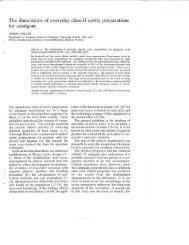
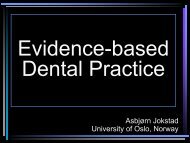
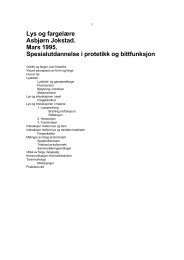

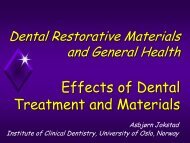
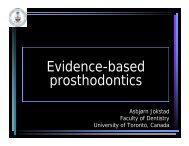

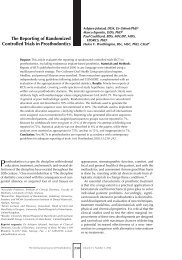
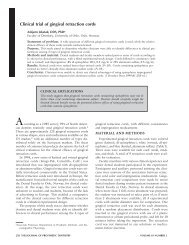

![[Sementer i fast protetikk] Scandinavian Society for Prosthetic](https://img.yumpu.com/18378889/1/190x245/sementer-i-fast-protetikk-scandinavian-society-for-prosthetic.jpg?quality=85)
